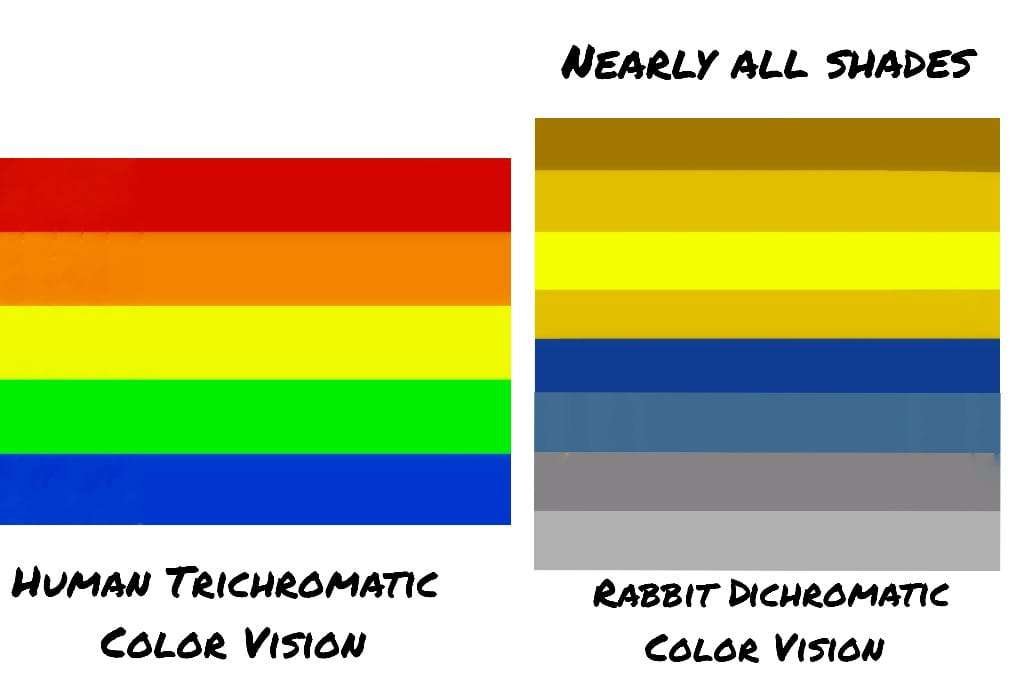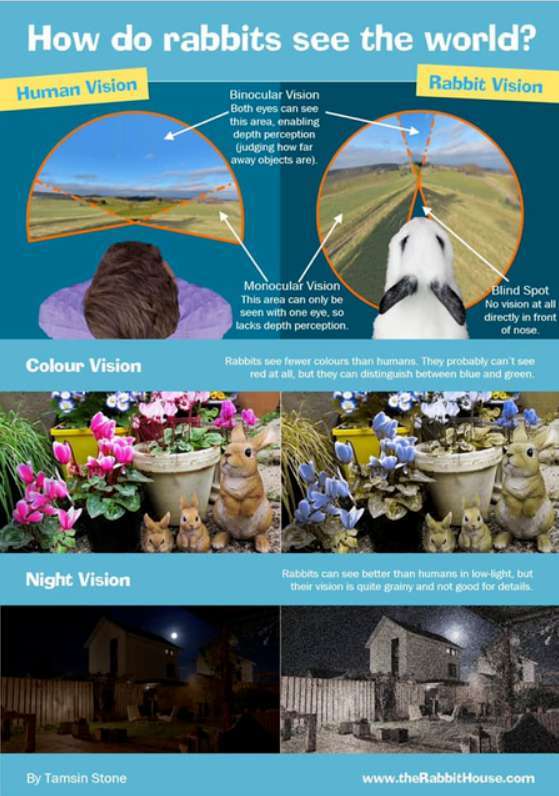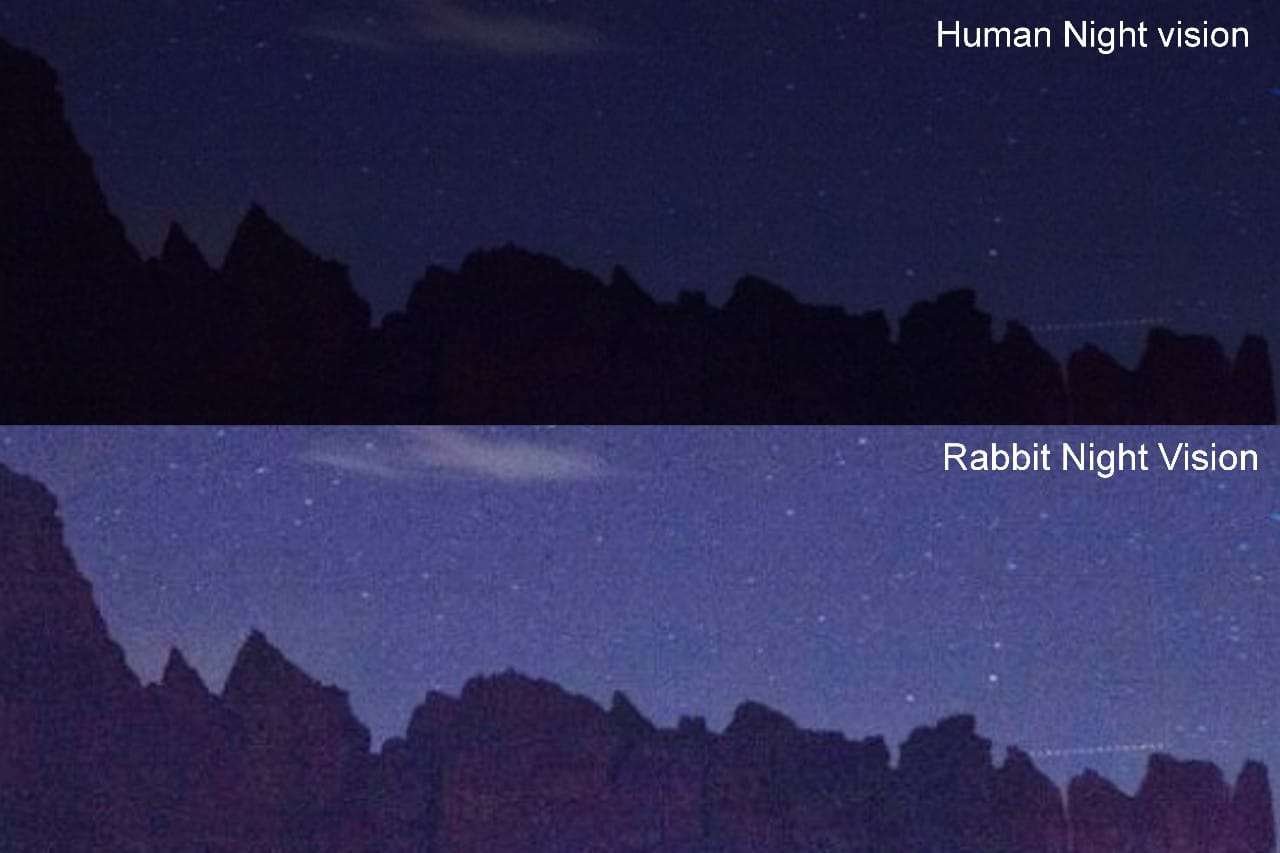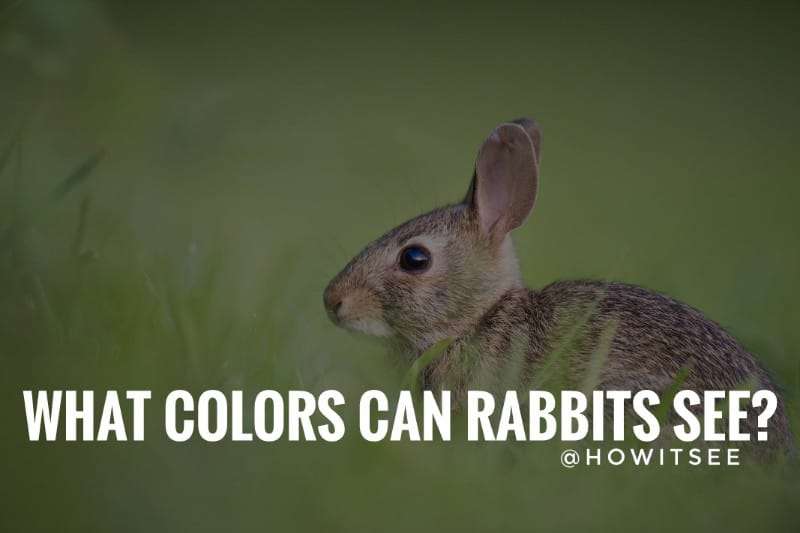Rabbits, also known as Bunnies, are from the family Leporidae. We all have glimpsed rabbits, and some of us pet them. They are small, cute and fluffy mammals.
So, rabbit owners or science lovers, have you ever wondered what colors can bunnies see or how they perceive the world? If yes, then this post is best for you.
The answer to the question, “What colors can rabbits see,” is: Rabbits or Bunnies can see the combination of only two colors, Green and Blue, with the wavelength of 520 nm and 425 nm, respectively. They have dichromatic vision. It means the absence of red cones from their eyes.
Rabbits see the world in green and blue shades. They cannot differentiate red variations.
However, their eyes evolve as prey, not a predator and have a lot of other capabilities in the vision that offers them an upper hand over the human vision.
Later in this post, we have explained “What do Bunnies see” in detail. So, without any further ado, let’s begin.
What colors can Rabbits see?
Rabbits see colors in the shades of blue and green. They are not completely color blind. Their eyes can sense colors but cannot differentiate as much as humans can.
Humans are trichromats meaning the cones in our eyes react to three colors, i.e., Blue, Green and Red. That’s why we can distinguish millions of color variations within the visible spectrum from 380 nm to 750 nm wavelength.
On the flip side, bunnies are dichromats meaning the cones in their eyes react to only two colors, i.e., Blue and Green.
Thence they can distinguish various color variations within the spectrum of 425 nm to 520 nm. Below we have attached the image of what color shades rabbits can discern.

The above image avails everyone to visualize what colors do bunnies capture. They are protanopic animals which denote they have red color blindness. If a person has red color blindness, they can perceive the world similar to bunnies.
Rabbit Eye as compared to Human Eye
The retinas in the eyes have photoreceptor cells known as rods and cones. On one side, rods help in scotopic vision (can differentiate light and dark shades), and cones help in photopic vision (can differentiate colors).
- Bunnies have a higher ratio of rods to cones than humans, which helps them catch the low-light and qualifies them to navigate at night.
- The cones in Bunnies’ eyes have 18,000 per sq. mm peak density and ten times fewer cones than humans. It signifies that they can recognize more varying color shades as compared to humans.
- In contrast, rods detect fewer details, and bunnies have about 300,000 per sq. mm. at peak density that is two times more than the number of humans. It assists them in catching the best in the dark.
- In a nutshell, rabbits or bunnies sense the world in colors but cannot recognize the millions of color variations as similar to humans.
How do Bunnies see the world?
Bunnies see the world in colors but in blue, grayish-green, and dull-yellow shades due to the absence of a large wavelength cone. Also, their vision is quite grainy but not good for details. They are dichromatic with less clear vision.

Image Source | wabbitwiki
On the other hand, humans have trichromatic vision. It means we can perceive small, medium, and large wavelength colors ranging from 380 nm to 720 nm.
We have all three kinds of cones that help us to perceive millions of color shades. Also, unlike rabbits, we see the world with much clarity and sharpness.
However, bunnies have superiority over us during the night. They have twice more rods than cones in their eyes. Their eyes are concentrated more on rods rather than cones.
Rods in the eyes helps to distinguish the world in low-light condition, whereas cones in the eyes assist in recognizing millions of color shades. Hence, bunnies can glimpse the world at night in a much brighter way than humans.
As justified by the image inserted above, rabbits have limited color perception and don’t have clear vision. Also, rabbits blink approximately 10 to 12 times an hour to see the world properly.
Bunnies have superiority over rods to glimpse much better in the dark, whereas humans have more cones in the eyes to distinguish millions of color shades.
Can Bunnies see in the Dark?
Yes, bunnies or rabbits can see in the dark because their eyes have two times more rods than humans support them to catch low-lighting at night. They are not nocturnal animals; they are crepuscular.
It means they are more active in dawn and dusk, corresponding to day and night. During dawn and dusk, the blue light comprises the majority part of the environment, which benefits them to see much better.

The rods in the eyes assist them in glimpsing much better in low light conditions. However, due to the absence of tapetum lucidum, a reflective membrane in their eyes, they cannot notice anything like humans in the darkness.
That’s why they love to spend time in their burrows at night. Bunnies predominately rely on their eyes rather than their eyes to sense the movement of predators. They are also very fast runners.
What colors do Rabbits like the most?
Rabbits like blue color shade the most because their eyes perceive different variations of blues in an attribute.
Blue color calms them to perceive different beauties of the world. At the same time, most rabbit owners claim that bunnies love to lie on the red. It is because due to the absence of large wavelength cones, they observe red in gray shades.
They categorize all the large wavelength colors in shades of gray. That’s why by when they see anything in a red or orange hue, their mind triggers as “it’s a dark place to sleep.”
How do Bunnies see humans?
Bunnies see humans in blue-green shades with low clarity. They are intelligent enough to categorize humans from different animals. However, it is difficult to say that they can also see the expression on human faces.
Also, their field of view is much larger than humans, with a pretty close to 360 degrees. Rabbits have a monocular vision which allows them to see in a wide area but in less depth.
Not only vision, but they also rely on their other senses, like smell and sound.
Also, many owners have shared their experience that bunnies can recognize them with sight, sound, and smell. It signifies bunnies or rabbits are one of the best pets.
In terms of vision, rabbits or bunnies are much inferior to many other animals due to the absence of large wavelength cones.
Rabbit vision vs Human vision
| Rabbit Vision | Human Vision |
| Rabbits are dichromatic. | Humans are trichromatic. |
| They can see the world in blue and green shades. | We can see the world in red, blue and green shades. |
| Rabbits have much better night/ low light vision. | Humans cannot see in the dark. |
| They have more grainy vision. | We have a clear vision. |
| Their eyesight is 8x more sensitive to light. | Our eyesight is less sensitive to light. |
Here, we conclude our article on “What colors can rabbit see,” along with other queries. We hope you like it. We will be back with another post. Till then, read the articles mentioned below. Stay tuned and stay healthy.
References-
Rabbit’s Vision by Vgr1
What is a rabbit’s field of vision by Wabbitwiki
Hughes, A. (1971). Topographical relationships between the anatomy and physiology of the rabbit visual system. Documenta Ophthalmologica, 30 (1), 33-159.
Do small things with great love.
Also Read:

Meet Abhidept (nickname Monty), the visionary founder of How It See, being an engineering student, he’s fueled by an insatiable curiosity about the world around him. He is captivated by an eclectic correlation between animal groups, science, and nature, and this fascination drives his quest for understanding.
After completing his degree, he’s set on a mission to delve deep into the realm of nature, accumulating knowledge to share with you through his writing. In the meantime, he loves to watch anime and read anime.
